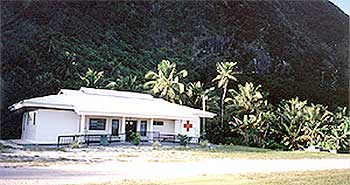 |
|||||||||
|
Outreach |
|
Delivers Continuing Clinical Education to Practitioners
In what may constitute one of the more arduous UW commutes, 12 School of Medicine faculty members have been taking 28-hour flights to deliver continuing medical education (CME) to health-care practitioners in the U.S.-associated Pacific Islands.
 |
Through PICCEP, Pacific Island health-care workers can continue their medical education at local island clinics such as the one shown here. |
For two years the Pacific Islands Continuing Clinical Education Program (PICCEP), based in the Department of Family Medicine, has provided CME to health professionals practicing in American Samoa, Commonwealth of the Northern Marianas, Federated States of Micronesia (includes the states of Yap, Chuuk, Pohnpei and Kosrae), Guam, Republic of the Marshall Islands and Republic of Palau.
A population the size of Portland, Ore., calls these 104 islands home. The area was a United Nations strategic-area trusteeship administered by the United States from 1947 to 1986. During that time, life on the islands shifted away from communal farming and fishing and became more Americanized. Withdrawal of international support has presented this area with several cultural and health-care issues. The islands still have well-organized communities with strong family traditions and sometimes powerful religious beliefs. However, U.S.-quality health-care services come at a price some areas are not able to maintain.
|
The Pacific Islands are home to communities that are experienicing a wide variety of cultural and health-care issues. PICCEP, which includes CME teams led by UW and WWAMI faculty members, helps Pacific Islanders gain access to quality medical care. |
 |
Dr. Ronald Schneeweiss, professor of family medicine, explained that the availability and sophistication of technology varies from a well-developed health infrastructure with a private insurance market in Guam to a single hospital facility with a seven-person staff on the island of Kosrae.
“We tend to think that these islands are all one culture, but they aren’t,” said Schneeweiss. “They are all different, which makes our job a bit harder. We are interested in presenting health-care workers in these areas with achievable goals.”
Currently there are no CME requirements for physicians in the Marshall Islands, the Micronesian states, and Palau. The backbone of the medical community on those islands is a staff of 70 medical officers trained at a five-year medical officer training program in the Micronesian state of Ponpei. That training program operated for 10 years beginning in 1986. There are also expatriate doctors, primarily from the Philippines, Burma, Sri Lanka, China, and the United States, who have contracts to practice for a certain amount of time.
Since autumn of 1998, the U.S. Health Resources and Services Administration has funded the PICCEP to assess the CME needs in each jurisdiction, provide continuing clinical education appropriate for the resources available in each island country, and create sustainable programs.
Beginning in winter of 2001, five teams led by UW faculty members traveled to one or two jurisdictions each to conduct a four-day, accredited CME course. Other faculty members have come from the WWAMI regional medical education program, the University of Hawaii and from within the target Pacific Islands. Over the past two years the PICCEP built strong relationships and trust within the islands’ health-care communities.
“We have had personal, direct contact with close to 200 health-care providers in the region who had never had any CME in the past,” noted Dr. Gary Hart, professor and director WWAMI Center for Rural Health Research and Center for Health Workforce Studies in the Department of Family Medicine. Hart is also the principal investigator for the PICCEP. “We need instructors with expertise in diabetes, pediatrics and infectious diseases. It’s a balancing act requiring someone who is highly trained and familiar with the technologies of the developed world, but who also is adaptable in conditions of limited resources.”
The PICCEP courses have been well received by the local doctors, nurses, and other health-care providers who have gone to great lengths to free up time to attend all CME sessions. On the island of Yap, radio broadcasts announced that the hospital would be closed to all except emergency cases during the CME courses.
The CME courses also include case discussions at the patients’ bedsides. Some PICCEP faculty members even accompany local doctors on housecalls. According to Schneeweiss, doctors and nurses in the South Pacific are too focused on technology and medicines rather than on prevention and education. In the future PICCEP will also try to help upgrade ancillary services in order to reduce off-island referrals. The courses to date have provided reassurance that these isolated physicians are indeed practicing modern-day, quality medicine.
“It’s not a knowledge deficiency as much as it is a resource deficiency,” said Schneeweiss. “Yet there’s a good spirit in these communities. It’s very inspiring. It’s hard for us to imagine practicing medicine under those conditions, and they do a pretty darn good job.”
|
| UW AMC Medical Center | UW School of Medicine | Harborview | UW MC | Search UW AMC | UW Home | Contact Us | ©2001-2002, University of Washington Academic Medical Center. All rights reserved. Please honor our copyrights. |
|